Abstract
OBJECTIVE--To examine the association between environmental exposure to lead and children's intelligence at age 11-13 years, and to assess the implications of exposure in the first seven years of life for later childhood development. DESIGN--Prospective cohort study. SUBJECTS--375 children born in or around the lead smelting town of Port Pirie, Australia, between 1979 and 1982. MAIN OUTCOME MEASURE--Children's intelligence quotient (IQ) measured at 11-13 years of age. RESULTS--IQ was inversely associated with both antenatal and postnatal blood lead concentrations. Verbal, performance, and full scale IQ were inversely related to blood lead concentration with no apparent threshold. Multivariate analyses indicated that after adjustment for a wide range of confounders, the postnatal blood lead concentrations (particularly within the age range 15 months to 7 years) exhibited inverse associations with IQ. Strong associations with IQ were observed for lifetime average blood lead concentrations at various ages. The expected mean full scale IQ declined by 3.0 points (95% confidence interval 0.07 to 5.93) for an increase in lifetime average blood lead concentration from 0.48 to 0.96 mumol/l (10 to 20 micrograms/dl). CONCLUSION--Exposure to environmental lead during the first seven years of life is associated with cognitive deficits that seem to persist into later childhood.
Full text
PDF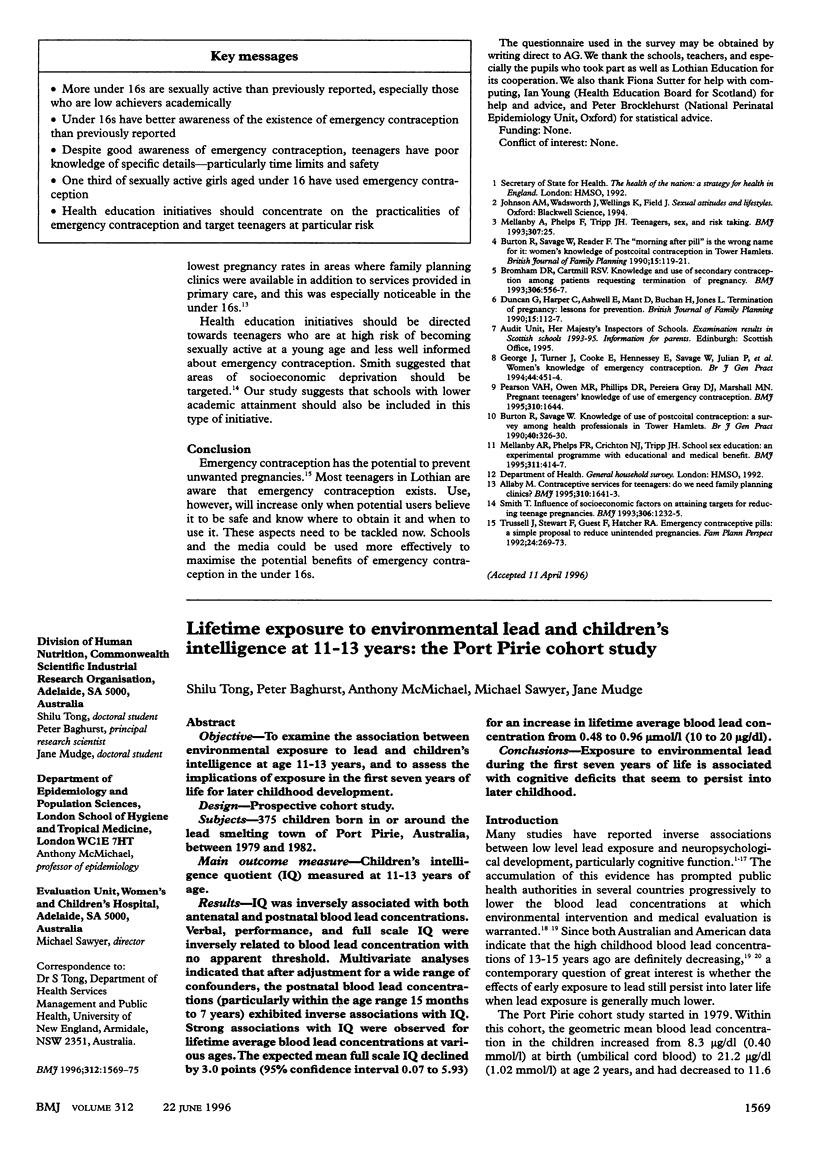
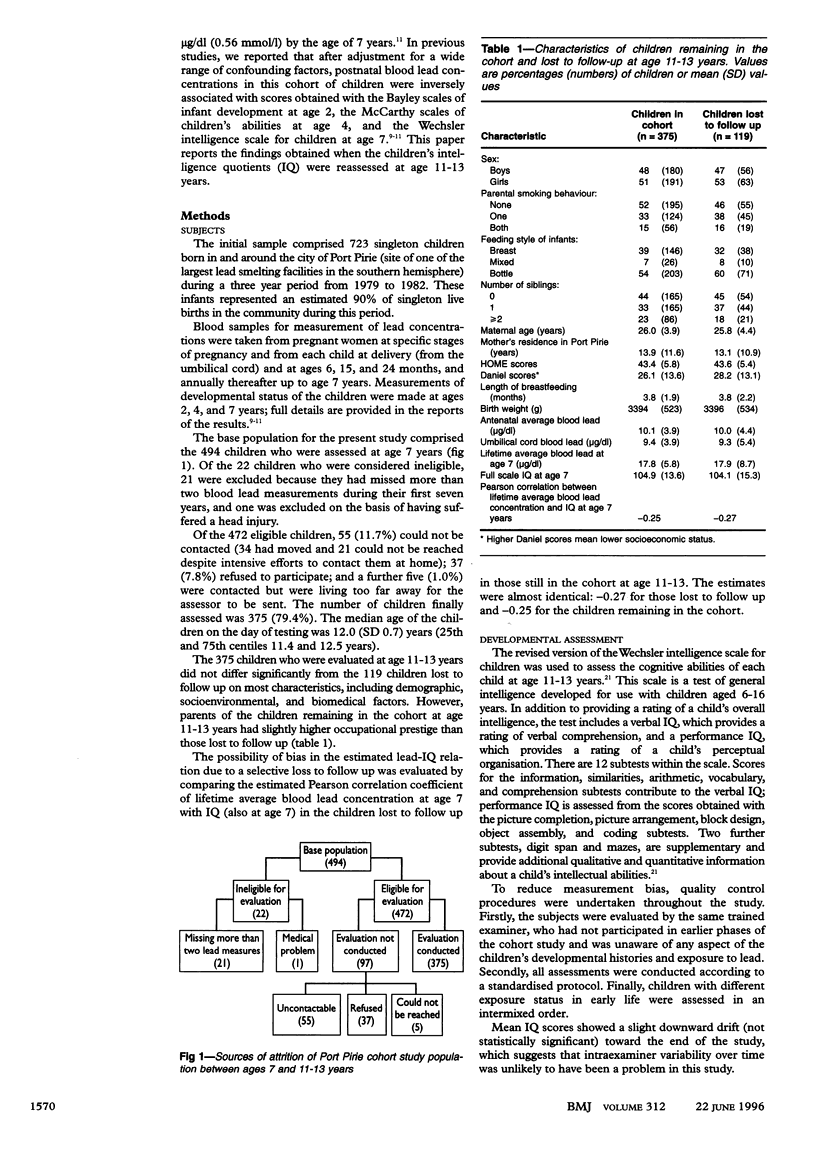
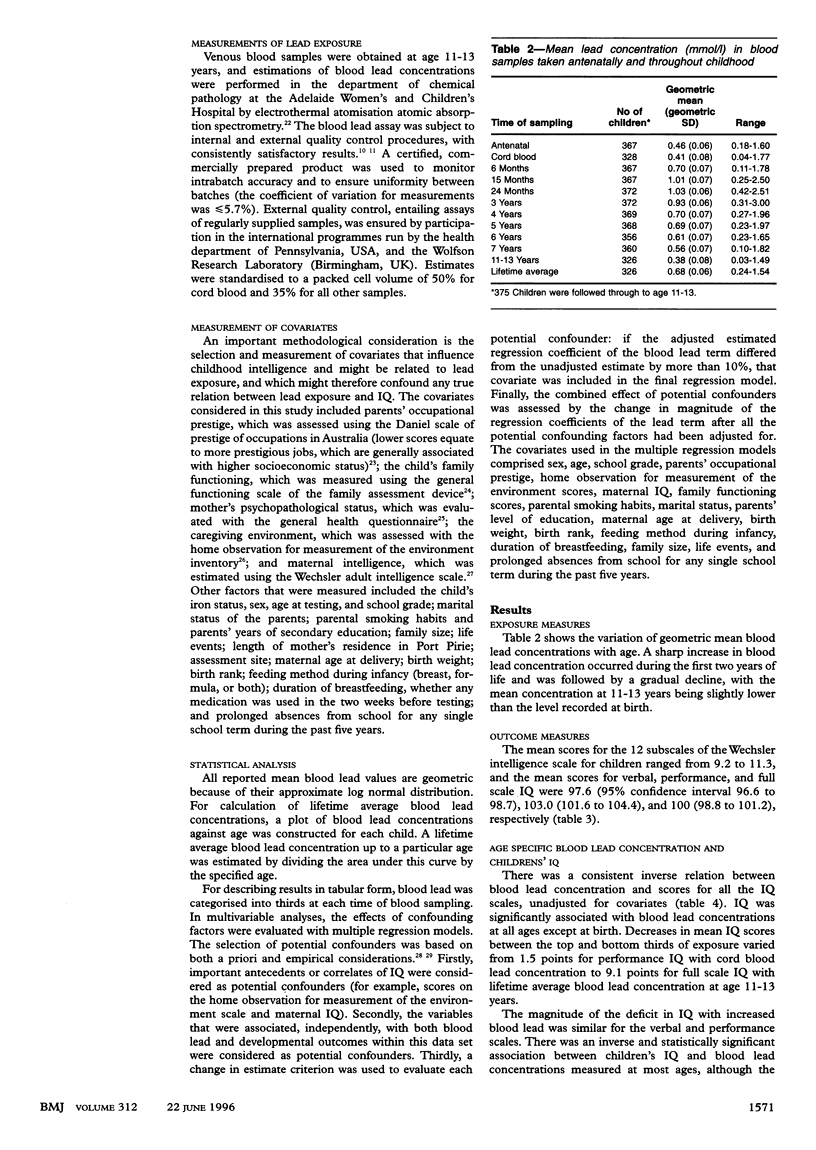
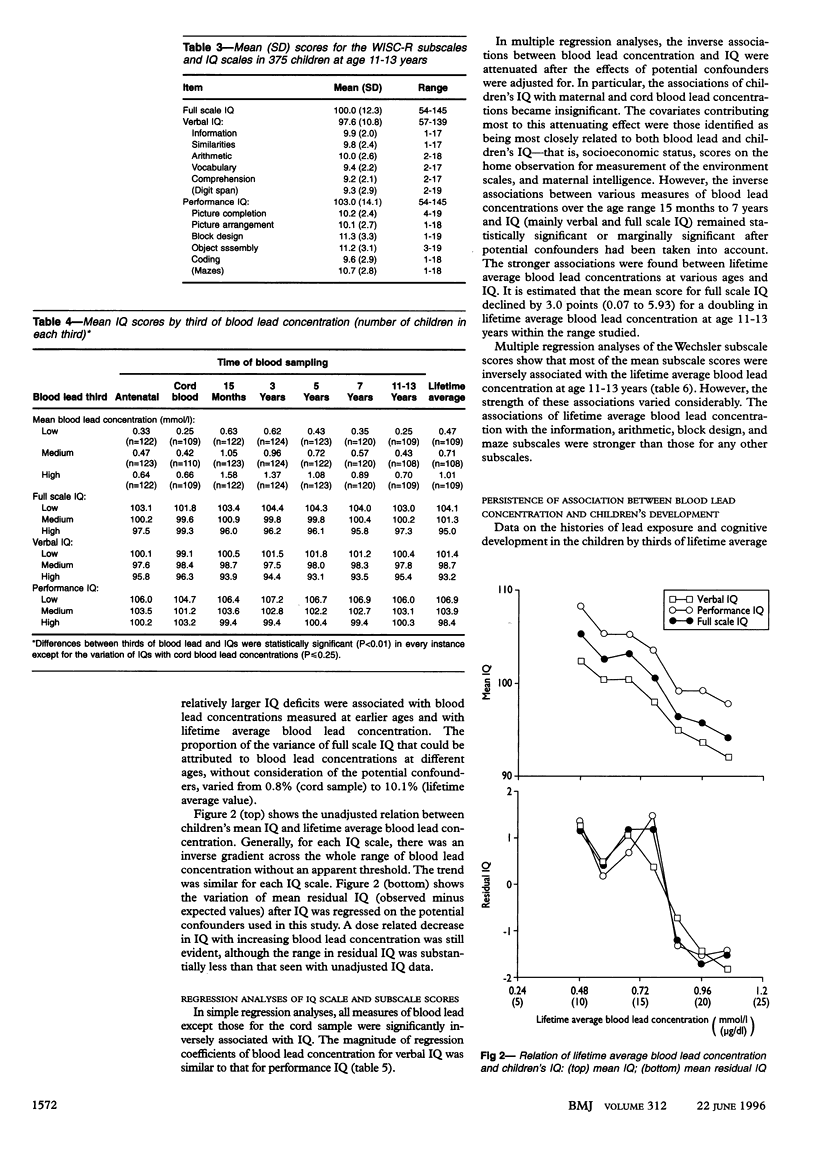
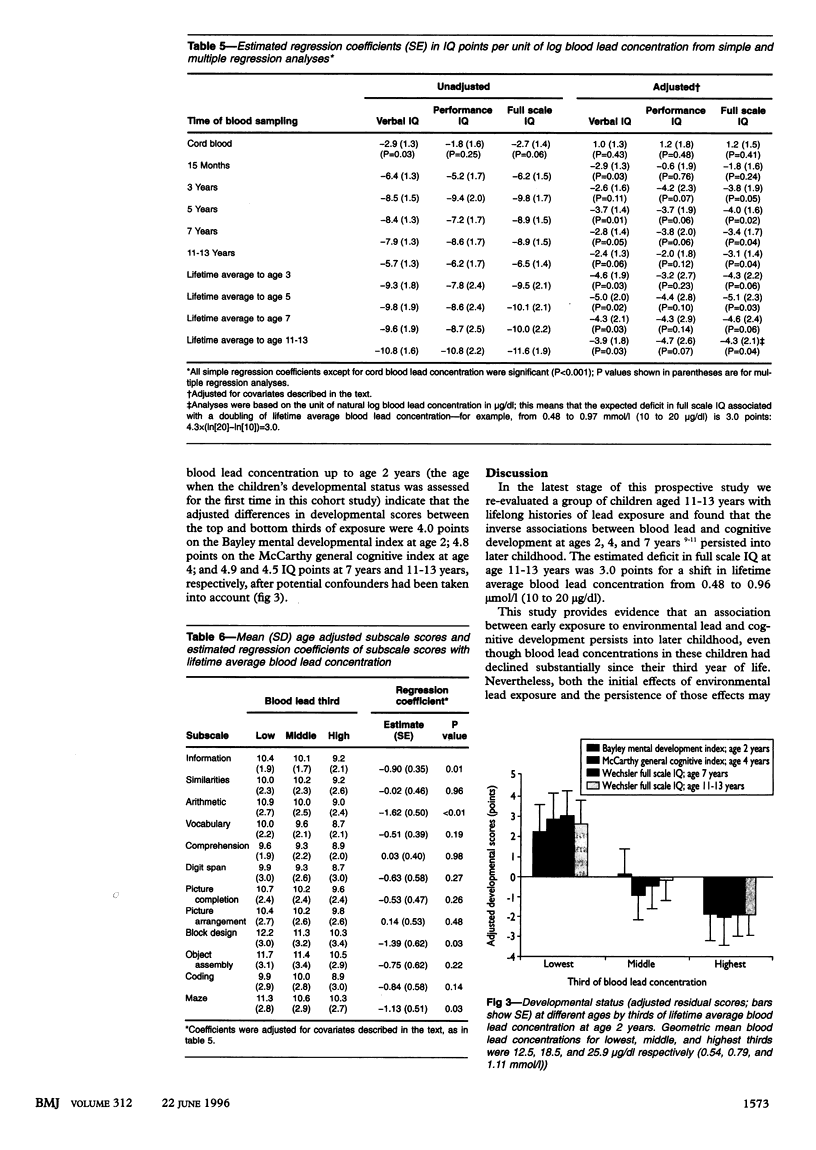
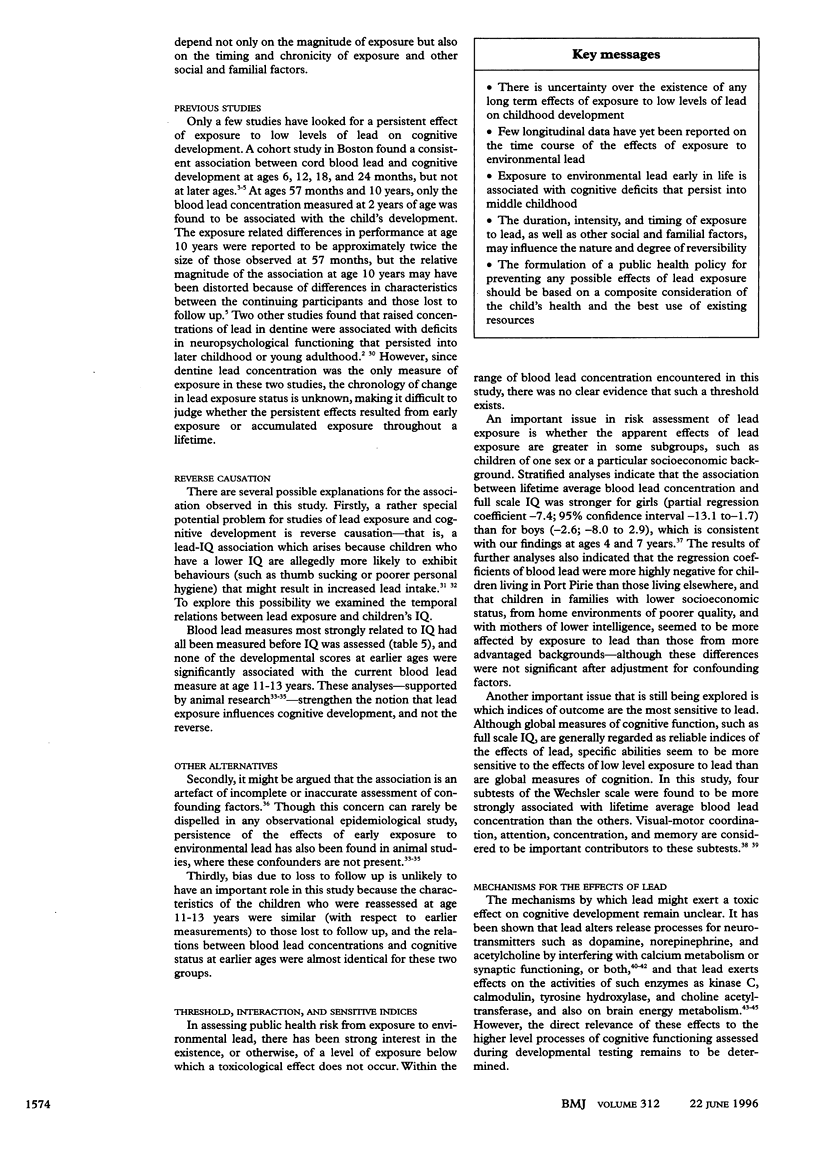
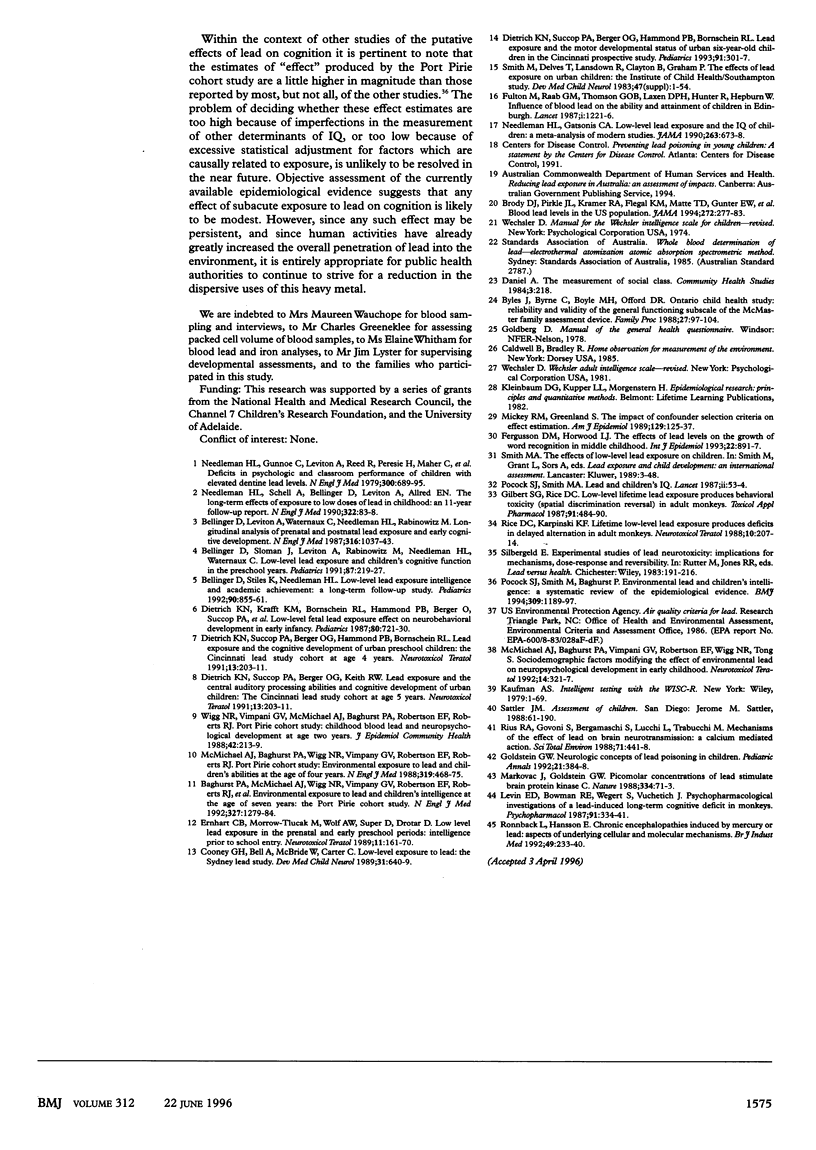
Selected References
These references are in PubMed. This may not be the complete list of references from this article.
- Baghurst P. A., McMichael A. J., Wigg N. R., Vimpani G. V., Robertson E. F., Roberts R. J., Tong S. L. Environmental exposure to lead and children's intelligence at the age of seven years. The Port Pirie Cohort Study. N Engl J Med. 1992 Oct 29;327(18):1279–1284. doi: 10.1056/NEJM199210293271805. [DOI] [PubMed] [Google Scholar]
- Bellinger D. C., Stiles K. M., Needleman H. L. Low-level lead exposure, intelligence and academic achievement: a long-term follow-up study. Pediatrics. 1992 Dec;90(6):855–861. [PubMed] [Google Scholar]
- Bellinger D., Leviton A., Waternaux C., Needleman H., Rabinowitz M. Longitudinal analyses of prenatal and postnatal lead exposure and early cognitive development. N Engl J Med. 1987 Apr 23;316(17):1037–1043. doi: 10.1056/NEJM198704233161701. [DOI] [PubMed] [Google Scholar]
- Bellinger D., Sloman J., Leviton A., Rabinowitz M., Needleman H. L., Waternaux C. Low-level lead exposure and children's cognitive function in the preschool years. Pediatrics. 1991 Feb;87(2):219–227. [PubMed] [Google Scholar]
- Brody D. J., Pirkle J. L., Kramer R. A., Flegal K. M., Matte T. D., Gunter E. W., Paschal D. C. Blood lead levels in the US population. Phase 1 of the Third National Health and Nutrition Examination Survey (NHANES III, 1988 to 1991) JAMA. 1994 Jul 27;272(4):277–283. doi: 10.1001/jama.272.4.277. [DOI] [PubMed] [Google Scholar]
- Byles J., Byrne C., Boyle M. H., Offord D. R. Ontario Child Health Study: reliability and validity of the general functioning subscale of the McMaster Family Assessment Device. Fam Process. 1988 Mar;27(1):97–104. doi: 10.1111/j.1545-5300.1988.00097.x. [DOI] [PubMed] [Google Scholar]
- Cooney G. H., Bell A., McBride W., Carter C. Low-level exposures to lead: the Sydney lead study. Dev Med Child Neurol. 1989 Oct;31(5):640–649. doi: 10.1111/j.1469-8749.1989.tb04050.x. [DOI] [PubMed] [Google Scholar]
- Daniel A. The measurement of social class. Community Health Stud. 1984;8(2):218–222. doi: 10.1111/j.1753-6405.1984.tb00446.x. [DOI] [PubMed] [Google Scholar]
- Dietrich K. N., Berger O. G., Succop P. A. Lead exposure and the motor developmental status of urban six-year-old children in the Cincinnati Prospective Study. Pediatrics. 1993 Feb;91(2):301–307. [PubMed] [Google Scholar]
- Dietrich K. N., Krafft K. M., Bornschein R. L., Hammond P. B., Berger O., Succop P. A., Bier M. Low-level fetal lead exposure effect on neurobehavioral development in early infancy. Pediatrics. 1987 Nov;80(5):721–730. [PubMed] [Google Scholar]
- Dietrich K. N., Succop P. A., Berger O. G., Hammond P. B., Bornschein R. L. Lead exposure and the cognitive development of urban preschool children: the Cincinnati Lead Study cohort at age 4 years. Neurotoxicol Teratol. 1991 Mar-Apr;13(2):203–211. doi: 10.1016/0892-0362(91)90012-l. [DOI] [PubMed] [Google Scholar]
- Ernhart C. B., Morrow-Tlucak M., Wolf A. W., Super D., Drotar D. Low level lead exposure in the prenatal and early preschool periods: intelligence prior to school entry. Neurotoxicol Teratol. 1989 Mar-Apr;11(2):161–170. doi: 10.1016/0892-0362(89)90055-x. [DOI] [PubMed] [Google Scholar]
- Fergusson D. M., Horwood L. J. The effects of lead levels on the growth of word recognition in middle childhood. Int J Epidemiol. 1993 Oct;22(5):891–897. doi: 10.1093/ije/22.5.891. [DOI] [PubMed] [Google Scholar]
- Fulton M., Raab G., Thomson G., Laxen D., Hunter R., Hepburn W. Influence of blood lead on the ability and attainment of children in Edinburgh. Lancet. 1987 May 30;1(8544):1221–1226. doi: 10.1016/s0140-6736(87)92683-3. [DOI] [PubMed] [Google Scholar]
- Gilbert S. G., Rice D. C. Low-level lifetime lead exposure produces behavioral toxicity (spatial discrimination reversal) in adult monkeys. Toxicol Appl Pharmacol. 1987 Dec;91(3):484–490. doi: 10.1016/0041-008x(87)90070-6. [DOI] [PubMed] [Google Scholar]
- Goldstein G. W. Neurologic concepts of lead poisoning in children. Pediatr Ann. 1992 Jun;21(6):384–388. doi: 10.3928/0090-4481-19920601-11. [DOI] [PubMed] [Google Scholar]
- Levin E. D., Bowman R. E., Wegert S., Vuchetich J. Psychopharmacological investigations of a lead-induced long-term cognitive deficit in monkeys. Psychopharmacology (Berl) 1987;91(3):334–341. doi: 10.1007/BF00518187. [DOI] [PubMed] [Google Scholar]
- Markovac J., Goldstein G. W. Picomolar concentrations of lead stimulate brain protein kinase C. Nature. 1988 Jul 7;334(6177):71–73. doi: 10.1038/334071a0. [DOI] [PubMed] [Google Scholar]
- McMichael A. J., Baghurst P. A., Vimpani G. V., Robertson E. F., Wigg N. R., Tong S. L. Sociodemographic factors modifying the effect of environmental lead on neuropsychological development in early childhood. Neurotoxicol Teratol. 1992 Sep-Oct;14(5):321–327. doi: 10.1016/0892-0362(92)90038-c. [DOI] [PubMed] [Google Scholar]
- McMichael A. J., Baghurst P. A., Wigg N. R., Vimpani G. V., Robertson E. F., Roberts R. J. Port Pirie Cohort Study: environmental exposure to lead and children's abilities at the age of four years. N Engl J Med. 1988 Aug 25;319(8):468–475. doi: 10.1056/NEJM198808253190803. [DOI] [PubMed] [Google Scholar]
- Mickey R. M., Greenland S. The impact of confounder selection criteria on effect estimation. Am J Epidemiol. 1989 Jan;129(1):125–137. doi: 10.1093/oxfordjournals.aje.a115101. [DOI] [PubMed] [Google Scholar]
- Needleman H. L., Gatsonis C. A. Low-level lead exposure and the IQ of children. A meta-analysis of modern studies. JAMA. 1990 Feb 2;263(5):673–678. [PubMed] [Google Scholar]
- Needleman H. L., Gunnoe C., Leviton A., Reed R., Peresie H., Maher C., Barrett P. Deficits in psychologic and classroom performance of children with elevated dentine lead levels. N Engl J Med. 1979 Mar 29;300(13):689–695. doi: 10.1056/NEJM197903293001301. [DOI] [PubMed] [Google Scholar]
- Needleman H. L., Schell A., Bellinger D., Leviton A., Allred E. N. The long-term effects of exposure to low doses of lead in childhood. An 11-year follow-up report. N Engl J Med. 1990 Jan 11;322(2):83–88. doi: 10.1056/NEJM199001113220203. [DOI] [PubMed] [Google Scholar]
- Pocock S. J., Smith M., Baghurst P. Environmental lead and children's intelligence: a systematic review of the epidemiological evidence. BMJ. 1994 Nov 5;309(6963):1189–1197. doi: 10.1136/bmj.309.6963.1189. [DOI] [PMC free article] [PubMed] [Google Scholar]
- Rice D. C., Karpinski K. F. Lifetime low-level lead exposure produces deficits in delayed alternation in adult monkeys. Neurotoxicol Teratol. 1988 May-Jun;10(3):207–214. doi: 10.1016/0892-0362(88)90019-0. [DOI] [PubMed] [Google Scholar]
- Rius R. A., Govoni S., Bergamaschi S., Lucchi L., Trabucchi M. Mechanisms of the effect of lead on brain neurotransmission: a calcium mediated action. Sci Total Environ. 1988 Jun 1;71(3):441–448. doi: 10.1016/0048-9697(88)90216-1. [DOI] [PubMed] [Google Scholar]
- Rönnbäck L., Hansson E. Chronic encephalopathies induced by mercury or lead: aspects of underlying cellular and molecular mechanisms. Br J Ind Med. 1992 Apr;49(4):233–240. doi: 10.1136/oem.49.4.233. [DOI] [PMC free article] [PubMed] [Google Scholar]
- Smith M., Delves T., Lansdown R., Clayton B., Graham P. The effects of lead exposure on urban children: the Institute of Child Health/Southampton Study. Dev Med Child Neurol Suppl. 1983;47:1–54. [PubMed] [Google Scholar]
- Wigg N. R., Vimpani G. V., McMichael A. J., Baghurst P. A., Robertson E. F., Roberts R. J. Port Pirie Cohort study: childhood blood lead and neuropsychological development at age two years. J Epidemiol Community Health. 1988 Sep;42(3):213–219. doi: 10.1136/jech.42.3.213. [DOI] [PMC free article] [PubMed] [Google Scholar]


